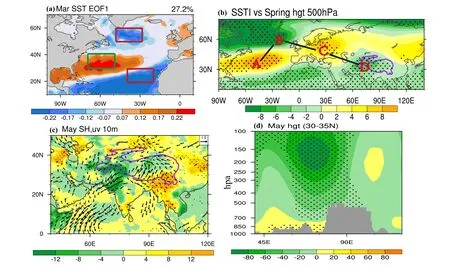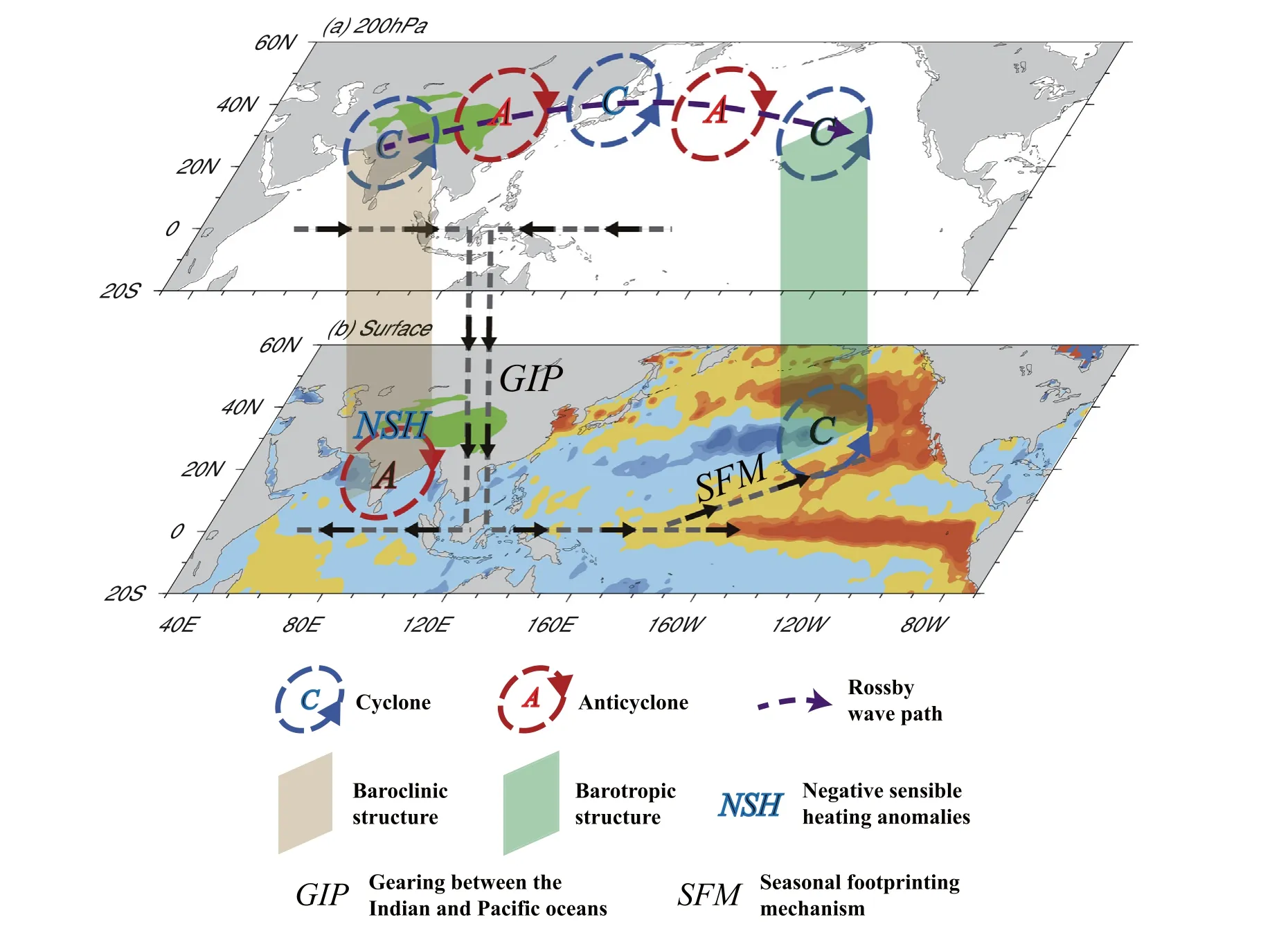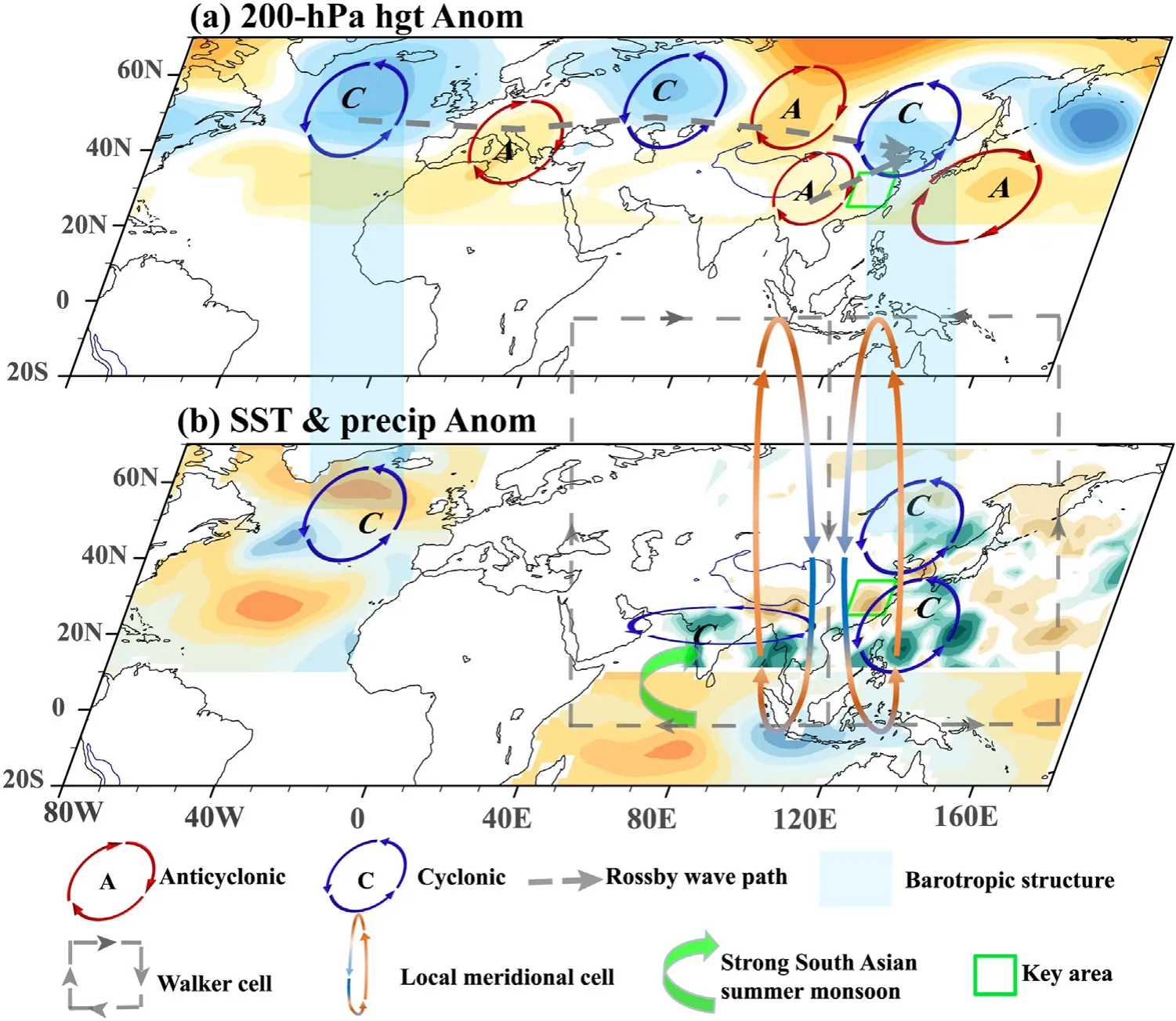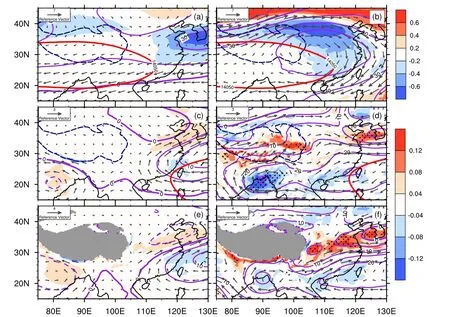The Tibetan Plateau bridge: Influence of remote teleconnections from extratropical and tropical forcings on climate anomalies
2024-03-04YiminLiuWeiYuJilnJingTingtingJingyuMoGuoxiongWu
YiminLiu , , Wei Yu , , Jiln Jing , , Tingting M , Jingyu Mo , Guoxiong Wu ,
a State Key Laboratory of Numerical Modeling for Atmospheric Sciences and Geophysical Fluid Dynamics, Institute of Atmospheric Physics, Chinese Academy of Sciences,Beijing, China
b University of Chinese Academy of Sciences, Beijing, China
c School of Atmospheric Sciences, Sun Yat-sen University, Southern Marine Science and Engineering Guangdong Laboratory (Zhuhai), Zhuhai, China
d Guangdong Province Key Laboratory for Climate Change and Natural Disaster Studies, Sun Yat-sen University, Zhuhai, China
Keywords:
ABSTRACT Recent advances in the bridging roles played by the Tibetan Plateau (TP) are reviewed in terms of the remote influence of circulation anomalies over the North Atlantic Ocean on Asian monsoon and El Niño-Southern Oscillation (ENSO) events, and in a clear link between the tropical oceans and Asian climate anomalies.The authors firstly introduce how the winter and spring anomalies in the North Atlantic Ocean affect the seasonal transition over the South Asian monsoon region and subsequent ENSO events on the interannual timescale.A distinct negative sensible heating-baroclinic structure in May over the TP is found to provide an intermediate bridging effect in this Atlantic-Asian-Pacific connection.In summer, the North Atlantic Oscillation is significantly correlated with the variations of East China summer rainfall, and it is the TP’s latent heating that plays the bridging role within.On the other hand, such a TP bridging effect also exists in the connection from the tropical oceans to extreme precipitation events over eastern China in summer, and from the midlatitude wave train to the biweekly oscillation of South China rainfall in spring.
1.Introduction
Understanding Asian climate variabilities is a major scientific challenge.Asian rainfall variations in relation to tropical ocean anomalies have been studied extensively by linking regional anomalous climate with sea surface temperature (SST) anomalies (SSTAs) over the tropical Pacific, Indian, and even Atlantic Ocean (e.g., Zhang et al., 1996 ;Weng et al., 2011 ; Ma et al., 2022 ; Zhang et al., 2022 ).Anomalous subtropical anticyclones over the Indian Ocean ( Liu et al., 2016 ; Xie et al.,2016 ) and western Pacific ( Wang et al., 2001 ; Jiang et al., 2022 ) in the lower troposphere are the key systems bridging warm or cold events in tropical oceans and East Asian climate.
In addition to forcing of tropical origin, the influence of the Europe-West Asia teleconnection from high latitudes on the South Asian monsoon in May has been considered through its modulation of the meridional gradient of tropospheric temperature and lower-tropospheric zonal winds ( Deng et al., 2016 ).It is noteworthy that while longer wavelengths can propagate poleward, wave trains will usually be trapped equatorward by the northern flank of the westerly jet in the Northern Hemisphere ( Hoskins and Karoly, 1981 ).Therefore, how perturbations in the mid-high latitudes influence the tropical Asian monsoon needs further elaboration.

Fig.1.(a) First empirical orthogonal function (EOF) mode of the North Atlantic SST in March and the corresponding explained variance.(b) Regression of spring 500 hPa geopotential height ( H , gpm) against SST index in March.The letters A- D represent the wave train centers.(c, d) Composite differences between strong positive and negative SWS dipole years in May.(c) SSH (shading, W m- 2 ) and surface wind (vectors, m s- 1 ).(d) H (gpm) averaged between 30°and 35°N (adapted from Yu et al.(2021) ).
The Tibetan Plateau (TP) is located in the subtropics of the eastern Eurasian continent.Its geographical position, altitude, area, and steep slopes in the south and east are the reasons why the TP is very important for regional and global climate (refer to the review papers of Wu et al.(2015) and Liu et al.(2020b).The thermal regime of the TP has multiple timescale variabilities, from the diurnal cycle to lowfrequency, seasonal, interannual, and interdecadal trends ( Duan and Wu, 2008 ; Liu et al., 2013 ; Wu et al., 2022 ).Yu et al.(2011) and Cui et al.(2015) pointed out that the generation and variation of plateau diabatic heating in spring are affected and restricted by atmospheric circulation and SST anomalies over the North Atlantic Ocean.Therefore,the TP could act as a bridge spanning from the mid-high latitude forcing on the tropical climate.Moreover, the TP could also improve the link from the tropical region to subtropical systems.Through these research efforts, our knowledge of the TP bridge and its role in climate variability has advanced over the past several years.
This paper reviews the state of our understanding of the roles played by the TP bridge.In Section 2, we review how the SSTA in the North Atlantic Ocean affects the seasonal transition of the South Asian monsoon and El Niño-Southern Oscillation (ENSO) events via changing the TP forcing in spring.The link between the North Atlantic Oscillation(NAO) in summer and the East Asian monsoon is presented in Section 3, while in Section 4, we demonstrate how the circulation variability over the TP associated with tropical anomalies stimulates extreme rainfall events in East China.Section 5 examines the TP bridge’s influence on the biweekly oscillation of spring rainfall over South China.
2.Influence of winter-spring North Atlantic SSTAs via the TP baroclinic mode
2.1.Interannual variability of the seasonal transition of the South Asian monsoon
Yu et al.(2021) investigated the physics of how the SSTA in the North Atlantic Ocean affects the seasonal evolution of the South Asian monsoon and proposed intermediate roles played by the TP.They found that the leading mode of the winter-spring North Atlantic SSTA is a tripole one ( Fig.1 (a)), which is closely correlated with the spring TP surface wind speed (SWS) or surface sensible heating (SSH) dipole mode.The positive North Atlantic tripole SSTA stimulates a steady downstream Rossby wave train, which propagates from the middle and northern North Atlantic to western Europe and the western TP ( Fig.1 (b)).Because of the persistence of the North Atlantic tripole SSTA, the Rossby wave train presents a quasi-stationary pattern from March to May, facilitating a cyclonic circulation occurring in the western TP ( Fig.1 (b)).This cyclone produces a spring TP SWS or SSH dipole mode, characterized by a southwesterly anomaly over the southern TP and an easterly anomaly over the northern TP.The southwesterly airflow of the cyclonic circulation in the mid-upper troposphere brings sufficient water vapor from the Arabian Sea to the southwestern TP, leading to a local increase in precipitation ( Fig.1 (b, d)).Then, a special configuration of negative SSH and a baroclinic circulation structure with a shallow anticyclonic circulation in the lower layer ( Fig.1 (c, d)) is built on the southwestern TP in May.Positive feedbacks are generated among the negative SSH anomaly, positive precipitation anomaly, and such baroclinic circulation over the western TP and northwestern India.The anticyclonic circulation is opposite to the summertime monsoon circulation( Fig.1 (c)), which weakens the cross-equatorial flow and water vapor transport, resulting in-situ precipitation reduction in South Asia.As a result, the South Asian summer monsoon is delayed.This is evident in numerical sensitivity experiments ( Yu et al., 2021 ).
2.2.Trigger processes for ENSO events

Fig.2.Schematic of the surface westerly wind anomalies over the equatorial western Pacific in May induced by the “negative sensible heating-baroclinic structure ”over the TP through the GIP and SFM processes (from Yu et al.(2022) ).
Considering the close linkage between the TP and ENSO trigger processes ( Nan et al., 2009 ; Wen et al., 2020 ), and the impacts of North Atlantic SSTAs on the TP ( Yu et al., 2021 ), the TP has been suggested to be an important bridge between North Atlantic SSTAs and tropical anomalies.By using data analysis and numerical sensitivity experiments with an AGCM and coupled GCM, Yu et al.(2021 , 2022 ) identified the role of the preceding winter-spring North Atlantic tripole SSTA in forcing the dipole mode of the spring TP SSH or SWS, which is one of the leading interannual modes ( Fig.1 (a, c)).They demonstrated that this dipole mode could also act as a trigger for subsequent winter ENSO events.Fig.2 shows the mechanism by which the positive phase of the spring TP SWS dipole mode ( Fig.1 ) affects the El Niño event through the following two pathways.Firstly, the zonal monsoon circulation over the tropical Indian Ocean and the Walker circulation over the tropical western Pacific are weakened.Secondly, the air-sea interaction over the North Pacific is modulated through the Rossby waves triggered by the TP.Furthermore, Yu et al.(2023) conducted coupled GCM sensitivity experiments with and without the TP and showed that the positive North Atlantic tripole SSTAs during winter and spring can generate a spring upper-level anomalous cyclone over the TP and the “negative SSH-baroclinic structure ”is self-sustained.However, excluding the TP significantly weakens the connection between the North Atlantic tripole SSTAs and subsequent ENSO events (Fig.S1).
3.Intermediate effect of the TP in the teleconnection between the summer NAO and East Asian monsoon
The TP plays an important bridging role not only in the influence of winter-spring North Atlantic SSTAs on South Asian and tropical anomalies, but also in the process of the summer NAO affecting the East Asian summer monsoon.Wang et al.(2018) found that the summer NAO is significantly connected to the summer precipitation variations over East China on interannual time scales, within which the thermal forcing of the TP affords intermediate bridging impacts.The summer NAO induces the TP rainfall anomaly through a large-scale wave train, and the condensation heating associated with the rainfall anomaly over the TP in turn excites the propagation of Rossby waves towards the downstream region.The authors indicated that an abnormal barotropic cyclone is formed in the northeast of the TP in the troposphere, comprising northerly wind anomalies in the lower troposphere over North China.Simultaneously, the TP heating causes low-level southerly wind anomalies in South China too.Thus, anomalous meridional winds converge in the lower troposphere and enhance the summer precipitation in East China.
4.Impacts of tropical oceans on East Asian extreme events through TP anomalous circulation
Additionally, the TP plays a crucial bridging role in the impact of tropical oceans on East Asian extreme events, as noted by Jiang et al.(2022) and Ma et al.(2022).
4.1.Influence of maritime continent convection on extreme drought over Southeast China via suppressed TP convection
Regarding the extreme drought over Southeast China from late summer to mid-autumn 2019, diverse mechanisms have been proposed ( Ma et al., 2020 ; Xu et al., 2020 ; Qi et al., 2021 ).Considering the evolution of large-scale circulation from August to October,Jiang et al.(2022) demonstrated synergistic effects of the mid-high latitude stationary wave and tropical circulation on the extreme drought in August and highlighted the relaying roles of the TP and western North Pacific in connecting the anomalies of tropical convection with the precipitation in Southeast China ( Fig.3 ).First, the equatorial SST gradient depressed the convection remarkably from the southeastern Indian Ocean to the Maritime Continent through reshaping the Walker circulation (gray dashed arrows in Fig.3 ).Second, the depressed convection stimulated the Southeast China drought circulation via two pathways.One was via the weakened convection over the southern TP and associated barotropic anticyclonic circulation around the TP forced by the thermal impacts of the horizontal gradient of enhanced convection in South Asia ( Liu et al., 2001 ).The other was via the positive vorticity anomalies established over the western Pacific in the lower troposphere forced by the strengthened convection over the Philippine Sea.Third, the Rossby wave train associated with the North Atlantic tripole SSTA and the Rossby wave responding to the TP precipitation deficiency generated an equivalent-barotropic cyclone over Northeast China (light gray arrows in Fig.3 ).This cyclone and the one over the subtropical western Pacific were in-phase in the meridional direction, so they were locked and sustained the barotropic instability ( Hoskins et al., 1985 ), resulting in exceedingly strong low-level northerly wind anomalies over East China.The above relationships are significant on the interannual time scale.

Fig.3.Schematic of the formation mechanism of the extreme Southeast China drought in August 2019: (a) 200-hPa geopotential height anomalies; (b) tropical Indian Ocean, tropical Pacific Ocean, and North Atlantic SSTAs (shading), with shading north of 10°N between 60°- 180°E representing the precipitation anomalies(adapted from Jiang et al.(2022) ).
4.2.Warmer Indian Ocean, high potential vorticity systems over the TP,and an excessive mei-yu in 2020
The warming of the Indian Ocean and the subseasonal phase shift of the NAO in 2020 caused extreme mei-yu rainfall in East China( Liu et al., 2020a ; Takaya et al., 2020 ; Ding et al., 2021 ).Whereas Ma et al.(2022) stated that the high potential vorticity (PV) systems from the TP were responsible for the extreme rainfall in the entire Yangtze River Valley, particularly over the upper reaches, during their eastward propagation.
The high PV systems’ activity was characterized by a significant diurnal cycle.Their formation was closely related to the strong SSH diurnal cycle over the TP and the condensation heating associated with cloud formation nearby 400 hPa, since diabatic heating tends to increase with height below 400 hPa during the night, which is beneficial to the generation of high PV systems.Compared with the climatology, due to the influence of the warmer Indian Ocean in summer 2020, convection was enhanced over the western Indian Ocean, which induced easterly winds and produced a significant negative PV anomaly, coupled with an anomalous anticyclone circulation over the northern Bay of Bengal.This anticyclone separated from the subtropical anticyclone anomaly over the western Pacific and supplied excessive water vapor towards the TP, resulting in a stronger thermal contrast and therefore enhanced activity of the high PV systems over the TP ( Fig.4 and Fig.S2).
5.Link between the midlatitude wave train and the biweekly oscillation of South China spring rainfall via TP SSH
The 10–20-day oscillation is a predominant intraseasonal oscillation of Southeast China spring rainfall (SCSR) in most years.Pan et al.(2013) found that the 10–20-day oscillation of SCSR is characterized by the alternating occurrence of huge anomalous anticyclones/cyclones encircling the TP in the lower troposphere, resulting in lower tropospheric divergence/convergence.In the middle and upper troposphere, the oscillation is represented by a series of southeastward propagating coherent wave trains.These wave trains also drift eastwards, and excessive SCSR is generated by the strong convergence of the upper troposphere alternately superimposed above the divergence in the lower troposphere in the Southeast China area.
The thermal structure of the 10–20-day intraseasonal oscillation of SCSR is closed with TP mechanical-thermal forcing, which is generated by the enhancement and weakening of the TP SSH (Fig.S3).Pan et al.(2013) further substantiated that negative TP SSH anomalies are associated with positive temperature anomalies over the western TP in the lower troposphere (Fig.S4(a)), accompanied by westerlies and weak ascending motion existing west of the geopotential height ridge.

Fig.4.PV anomalies (shading, PVU), geopotential height (purple contours, m), and wind (vectors, m s- 1 ), relative to the June-July climatic mean (1979–2020) at(a, b) 150 hPa, (c, d) 500 hPa, and (e, f) 700 hPa during (a, c, e) the historical mei-yu period and (b, d, f) the extreme mei-yu season in 2020.The red solid lines denote the climate mean 14,050 isoline in (a, b) and 5750 isoline in (c, d).The dark blue lines in (a- d) mark the elevation of 3000 m.PV anomalies exceeding 2.5 standard deviations are highlighted by black dots (from Ma et al.(2022) ).
6.Summary
In spring and summer, an extensive influence of the TP is apparent via its coupling with the Asian summer monsoon.Through this interaction, the TP modulates the westerlies, hemispheric Rossby wave trains,and zonal and meridional vertical cells.Recent advances have significantly improved our scientific understanding of the climatic impacts of the TP, which can be summarized as follows.
(1) The special location of the TP shapes its unique role as a bridge in the interactions of different latitudes.The North Atlantic SSTA in winter and spring affects the seasonal process of the South Asian monsoon in spring by causing a negative sensible heat baroclinic mode over the TP.It also contributes to ENSO occurrence through the India-Pacific gearing and seasonal footprint mechanism.
(2) Tropical Indo-Pacific Ocean anomalies can directly affect the climate of East Asia by generating circulation anomalies in the western Pacific or northern Indian Ocean.At the same time, it also generates a Rossby wave train and strengthens the western Pacific circulation anomaly by affecting the thermal anomaly of the TP, leading to the occurrence of extreme precipitation events in East Asia.
(3) The intraseasonal variations of high PV systems and SSH are formed on the plateau through the tropical ocean or the midlatitude quasi-bicycle wave train, which directly leads to the intraseasonal variation in extreme precipitation in East China.
The TP will continue to play unique roles in the warming of global climate.In view of its importance in the prediction of extreme events within the Asian climate, focus could be placed on the following aspects.While carrying out theoretical and simulation-based research in the future remains important, it is also necessary to conduct more field campaign observations and improve model performances to reveal the nature of sea-land-atmosphere interaction over the TP and the East Asian monsoon region.The use of new methods to characterize the dynamic and thermal effects of the TP with the PV will help in studying the effects of the plateau quantitatively and more comprehensively ( He et al.,2022 ).Evaluating and quantifying aerosol-monsoon interaction is also a great challenge, but necessary to improve the representation of physical processes in models.In short, collaborative efforts are still needed as we strive to move forwards with observing, simulating, and ultimately better understanding climate roles played by the TP and the underlying dynamic mechanisms involved.
Disclosure statement
No potential conflict of interest was reported by the authors.
Funding
This study was jointly supported by the Guangdong Major Project of Basic and Applied Basic Research [grant number 2020B0301030004 ]and the National Natural Science Foundation of China [grant number 91937302 ].
Supplementary materials
Supplementary material associated with this article can be found, in the online version, at doi:10.1016/j.aosl.2023.100396.
杂志排行
Atmospheric and Oceanic Science Letters的其它文章
- Slowing down of the summer Southern Hemisphere Annular Mode trend against the background of ozone recovery
- Comparison between ozonesonde measurements and satellite retrievals over Beijing, China
- Decadal prediction skill for Eurasian surface air temperature in CMIP6 models
- Ascending phase of solar cycle 25 tilts the current El Niño–Southern oscillation transition
- Anthropogenic influence on the extreme drought in eastern China in 2022 and its future risk
- Effect of different cold air intensities and their lagged effects on outpatient visits for respiratory illnesses in Handan in different seasons
